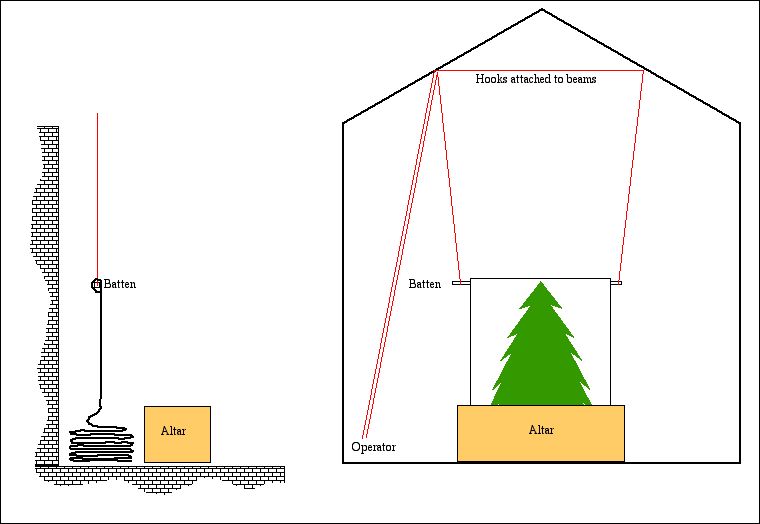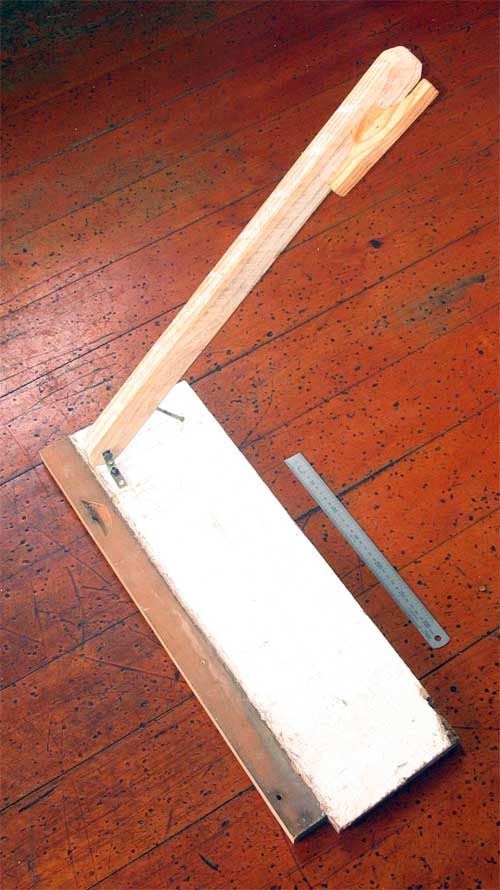
The tree is a painting on cloth, perhaps 6m high by 3m wide, of a fir tree, with wooden battens at top and bottom. At the beginning of the service, it is folded on the ground behind the altar. As the service proceeds, the tree is lifted stage by stage and significant attachments added. By the end of the service, the tree is fully extended.
It is suspended by two strong cords, one at each side, which pass over hooks judiciously attached to the roof beams, and down to an operator. ( We used hooks rather than pulleys because we didn't have any pulleys, and we were - as usual - in a hurry; in practice, the hooks were probably better because the extra friction made it easier to hold one string still while adjusting the other. )
The tree operator is concealed from view ( originally behind furniture and an ornamental palm in the front left corner of the church, but more generally improvised ). He doesn't do anything particularly alarming, but we decided that to have him in full view would be an unhelpful distraction. As the service proceeds, he must raise the tree step by step. We found it adequate to do this without any clever bits, pulling the strings by hand and fixing them on a cleat between raises. We found it necessary to keep the strings separate; an early experiment with the strings wound in parallel onto a single drum failed because of unpredictable and unsymmetrical stretching in the strings.
Obviously, the operator must be able to see what's going on well enough to judge how far the tree should be raised at each stage.
To fasten things to the tree we appoint a tree attendant. It might be possible for the tree operator to do both jobs, but keeping them separate ensures that the tree can be raised smoothly immediately after the attendant has attached some new object.
Click the picture for a separate version.
 The cleat deserves a little elaboration. It has to be big enough to hold several ( around 12 for our dimensions ) metres of cord, easily usable by someone in a fairly confined space, portable, and stable. Our was built on a largish baseboard which could be weighted down if necessary. The cleat was attached to a pivoted stem long enough to bring it up to a convenient level for someone sitting on a stool; the pivot ensured that the stem would align automatically with the supporting cords without awkward bending forces. It was also convenient to add a support to hold it at a reasonable height when not under tension; this was just a nail of convenient length hammered into the stem at a convenient place.
The cleat deserves a little elaboration. It has to be big enough to hold several ( around 12 for our dimensions ) metres of cord, easily usable by someone in a fairly confined space, portable, and stable. Our was built on a largish baseboard which could be weighted down if necessary. The cleat was attached to a pivoted stem long enough to bring it up to a convenient level for someone sitting on a stool; the pivot ensured that the stem would align automatically with the supporting cords without awkward bending forces. It was also convenient to add a support to hold it at a reasonable height when not under tension; this was just a nail of convenient length hammered into the stem at a convenient place.
The picture should give a fair idea of the construction; there's not much critical about it. Click the picture for a separate ( bigger ) version.
It worked very well. In practice, it turned out that there was rather little need for heavy weights; perhaps that was another advantage of using hooks rather than pulleys.
We used this structure in two of our services :
2009 October